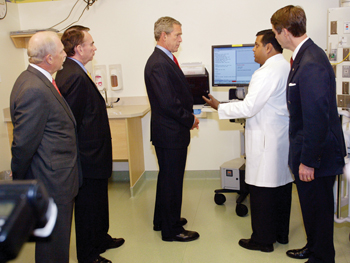
Staff move a young patient across the 400-foot-long connector between the old Children's Hospital and the new Monroe Carell Jr. Children’s Hospital at Vanderbilt. Faculty, staff and many volunteers helped move 112 patients and equipment to the new building in early February.
photo by Dana Johnson

During a visit in May, President Bush listens as Neal Patel, M.D., right, explains a computer system in a patient room as Harry Jacobson, M.D., left, then-Secretary of Health and Human Services Tommy Thompson, second from left, and U.S. Sen. Bill Frist, right, look on.
photo by Dana Johnson

A rendering of MRB IV, currently under construction on top of Light Hall and Langford Auditorium.
Editor's note — The following, in no particular order, is a roundup of the news that made headlines at Vanderbilt University Medical Center this year.
Elevate program launched
Leaders announced plans to 'elevate' Vanderbilt University Medical Center. That's the name of the program aimed at renewing and sharpening the commitment to service and operational excellence. In meetings Nov. 22 and 23, some 900 VUMC managers got a daylong look at the principles, goals and strategies that leaders say will help take the VUMC clinical enterprise to new levels.
Elevate centers on the adoption by VUMC leaders and managers of certain principles and practices packaged by the Studer Group. The nine basic principles of elevate are: commit to excellence; measure the important things; build a culture around servic; create and develop great leaders; focus on employee satisfaction; build individual accountability; align behaviors with goals and values; communicate at all levels; and recognize and reward success.
VCH on the move
In February the Monroe Carell Jr. Children's Hospital at Vanderbilt made its patient-friendly debut, becoming the area's first free-standing, full-service children's hospital. Approximately 150 children staying at the Vanderbilt Children's Hospital inside Vanderbilt University Medical Center were moved through a connector bridge, 400 yards from their original rooms on floors four, five and six, to the new facility. In December, the Children's Hospital opened the first three floors of the Doctors' Office Tower, which will be the new centralized home to many of the pediatric outpatient clinics where about 180,000 children a year are treated and which are currently spread across the Medical Center.
VUSM among top in “U.S. News” rankings
Vanderbilt University School of Medicine garnered recognition once more as being among the leading medical institutions in the United States.
In the spring, U.S. News and World Report ranked VUSM 15 out of 125 accredited medical schools in the United States in its annual scoring of graduate and professional schools. U.S. News bases it's rankings on a weighted average of different indicators such as research activity, peer assessment, student selectivity and faculty resources. In a separate section of the same rankings, the magazine named the Vanderbilt Audiology Program as the top such program in the nation. In its July listing of the nation's best hospitals, U.S. News and World Report rated VUMC among the top 50 in nine of the 12 major specialties ranked.
New Oates Institute to focus on drug discovery research
Drug discovery research got a boost with the launch of the John A. Oates Institute for Experimental Therapeutics.
Experimental therapeutics is “the very broad area of understanding how drugs work in the body, why not everyone responds to drugs the same way, and how we can use that information to make better use of the drugs we have and to develop new drugs,” said Dan M. Roden, M.D., William Stokes Professor of Experimental Therapeutics and new director of the Oates Institute.
Research describes major cause of infant pneumonia
Researchers at the Monroe Carell Jr. Children's Hospital nailed down a clear picture of a newly described virus that is a leading cause of pneumonia in babies. A study that appeared in the New England Journal of Medicine defined the “who, how and how much” of the impact of human metapneumovirus (MPV) on children.
After examining samples and data from more than 2,000 infants and children, seen over the course of 25 years and stored in refrigerators at the Vanderbilt Vaccine Clinic, James E. Crowe, M.D., associate professor of Pediatric Infectious Diseases, and his team found MPV was the apparent cause of up to 12 percent of lower respiratory illness in the first year of life, rivaling the No. 1 culprit, respiratory syncytial virus (RSV).
TennCare’s fate
The future of TennCare remains in limbo. This fall Tennessee Gov. Phil Bredesen announced plans to dismantle the 10-year-old program — which provides health coverage to 1.4 million people in the state who are poor, disabled or otherwise unable to obtain health insurance — and return to Medicaid. He pointed to TennCare's spiraling costs, reduced federal funds and litigation brought by the Tennessee Justice Center advocacy group, which have immobilized efforts to reform the program and trim its cost, as the primary reasons for the move.
The two side are still in negotiations to determine of the TennCare program can be salvaged.
Technology in health care focus of Presidential visit
President George W. Bush visited the Monroe Carell Jr. Children's Hospital at Vanderbilt and later joined a conversation in Langford Auditorium about health care information technology during a two-hour Medical Center visit in May.
The President learned about Vanderbilt's strides toward utilizing health care information technology to improve patient care and hospital operations during the afternoon visit.
At the Children's Hospital, Bush was given a demonstration of Vanderbilt's hospital clinical information system, including the computer physician order entry system, WizOrder, that helps guide drug dosing for patients, checks for allergies and provides physicians the tools to make the best decisions possible.
Blakely, Burk receive MERIT awards
Two VUMC researchers this year landed coveted MERIT (Method to Extend Research In Time) Awards from the National Institutes of Health. Randy Blakely, Ph.D., director of the Center for Molecular Neuroscience, was awarded a MERIT Award from the National Institute of Mental Health based in part on his research on the cholinergic system, a major neurotransmitter system of the brain and peripheral nervous system. Raymond F. Burk, M.D., professor of Medicine and Pathology, received a MERIT Award from the NIH for his research on the nutritional effects of selenium. The awards honor researchers who have shown superior competence and productivity over their research careers and provides funding support.
VUMC NIH funding rate growing fast
Over the past five years, Vanderbilt University Medical Center experienced unprecedented growth in National Institutes of Health (NIH) funding, achieving the highest growth rate in the United States. With a compound annual growth rate of 22.4 percent from 1999 to 2003, Vanderbilt topped Duke University and UCLA for the lead position.
Stem cell center launched
Vanderbilt University formalized its commitment to one of the hottest areas of science — stem cell research — with the creation of the Vanderbilt Center for Stem Cell Biology (VCSCB). The new center, under the direction of Mark A. Magnuson, M.D., assistant vice chancellor for Research, is designed to harness existing research strengths on campus and to stimulate growth in this promising scientific area.
Stem cells are the basic building blocks for the body's many different tissues, and scientists believe that in the future these cells could be used to generate replacement cells and tissues as treatments for diseases ranging from diabetes to Parkinson's to heart disease.
VUMC 'leaps' to forefront in new ranking
A report from a coalition of U.S. employers confirmed Vanderbilt's standing as a national leader in adopting measures for patient safety and health care quality. The report is from the Leapfrog Group, 150 large companies providing health benefits to more than 34 million consumers spread among all 50 states.
The 2004 Leapfrog Group Hospital Quality and Safety Survey took in 1,664 hospitals located in 24 regions where the member companies in Leapfrog are considered to have large concentrations of employees. In all, the survey covered 2,105 of the nation's approximately 3,900 Medicare-approved acute care hospitals. The idea behind Leapfrog is to encourage hospitals to undertake certain important “leaps” in quality and patient safety.
VIOXX flap caused some pain to researchers
Arthritis patients weren't the only ones concerned about the withdrawal of the anti-inflammatory drug Vioxx from pharmacy shelves: Cancer scientists worry the decision may hinder research aimed at preventing colorectal cancer.
Merck & Co. pulled its blockbuster medication from the market in September because patients in a long-term study who took the drug had an increased risk of heart attack and stroke.
“The Vioxx trial would have provided important mechanistic information on polyp prevention,” says Larry Marnett, Ph.D., director of the Vanderbilt Institute of Chemical Biology. “There was no choice but to stop it, but potentially valuable information may have been lost.”
Group validates human subjects protection efforts
Vanderbilt University's program to protect human research participants was stamped with an important seal of approval. The Association for the Accreditation of Human Research Protection Programs (AAHRPP) awarded full accreditation to Vanderbilt, the 13th organization to achieve this status.
AAHRPP accreditation is voluntary and includes a self-assessment process and on-site evaluation by peer reviewers. The process evaluates the entire program of human research participant protection, of which the Institutional Review Board is the largest part.
Nurse shortage looms despite gains: study
The number of registered nurses entering the job market appears to be rising steadily, with a total employment growth of over 200,000 R.N.s since 2001, the largest increase since the early 1980s, but experts at the School of Nursing say it's still not enough to prevent a long-term crisis that threatens to cripple the entire health care system.
The new numbers came from Peter Buerhaus, Ph.D., Valere Potter Professor of Nursing; senior associate dean for Research at the School of Nursing, in an article that appeared in the health policy journal Health Affairs. “While R.N.s over age 50 have provided much of the expansion of hospital employment since 2001, it is striking that in 2003, employment of younger R.N.s grew by nearly 90,000, reaching the highest level observed since 1987,” said Buerhaus.
“This entry of younger nurses into the workforce is consistent with reports of substantial gains in enrollments at nursing schools since 2001, and may represent the first wave of two-year program graduates.”
Construction rolls on
The Medical Center's growth is on an upward track, as evidenced by the numerous construction projects under way. Among the new facilities, renovations and expansions in the works are:
• Medical Research Building IV — The $110 million expansion above Light Hall is expected to be completed by next summer.
• Emergency Department — $12 million expansion and renovation should be completed by Spring 2005.
• Medical Center East South Tower — This $79 million project is being done in two phases and should be complete by next spring.













